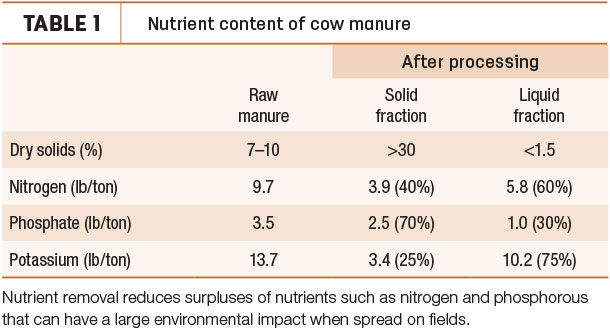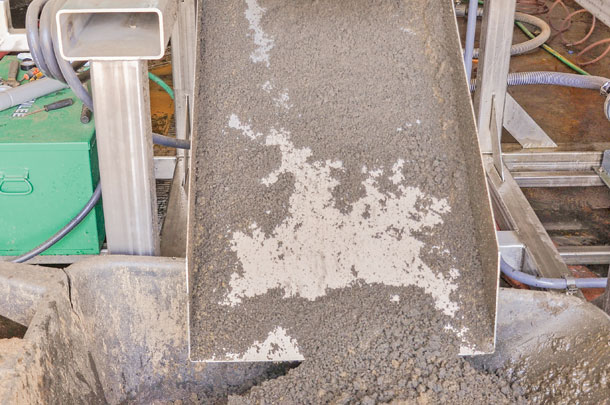Nutrient removal systems for manure management have been around the dairy industry for more than 10 years, yet very few dairies in the U.S. are currently utilizing these systems. The cost of equipment, operating expenses and additional labor needs are major considerations when it comes to an installation.
Even so, you may be missing out on a huge opportunity for your dairy.
Nutrient overload
Many nutrients found in dairy cattle manure are highly regulated when it comes to the allowable volume per acre spread on fields. The aim of nutrient removal is to process liquid manure so nutrient surpluses are minimized, and the resulting product can be effectively put to use on the farm and in the fields.
Of the major nutrients present in manure, nitrogen and phosphorus are difficult to manage and can have the largest environmental impact. Nutrient removal systems can help concentrate and control these nutrients by binding solids together and utilizing gravity to separate solids from liquid waste (Table 1).

Once nutrients are captured, a secondary process of water purification such as ultra-filtration or reverse osmosis can help remove additional nutrients from liquid waste that are hard to capture through a mechanical removal process.
For example, potassium is a dissolved solid and can be difficult to remove solely through a nutrient removal process. Phosphorus is another challenging nutrient to remove.
A mechanical nutrient removal process can capture the majority of phosphorus; however, chemical addition or water purification is needed to remove 100 percent of the phosphorus in liquid manure.
Added benefits
Nutrient removal processes can be coupled with a process to reduce bacteria which can be harmful to groundwater if spread on fields at too high of a level. Reducing or removing the nutrients bacteria feed on in the manure can help control bacteria counts when it is spread on fields.
Adding a nutrient removal process to a manure management system can also give farms flexibility when increasing cow numbers with limited acreage. Removing nutrients from the manure could allow an increased amount of liquid to be applied without purchasing extra acres.
Additionally, liquid manure put through a secondary water purification process using ultra-filtration and reverse osmosis can be re-utilized on the farm. Reusing this water supply to clean manure equipment, in the parlor washdown or in other areas on the farm can help you see a higher return on investment.
Pre-separation
To get the most out of a nutrient removal system, a pre-separation process is encouraged to remove long fibers, larger particles or any foreign objects that can clog or damage nutrient removal equipment.
Pre-separation is completed before manure reaches the nutrient removal stage and can be done through a sand lane system, lift auger, slope screen or other separation equipment.
The pre-separation process is especially critical when working with sand bedding and nutrient removal systems. For example, if you use a dissolved air flotation system for nutrient removal without pre-separation, sand can plug up the water discharge valves. With a micro-screen, sand can get caught in the fine openings, rendering the system useless.
The abrasiveness of sand particles can also cause damage to the internal components of a centrifuge system. A pre-separation process removes the majority of sand particles, increasing the effectiveness of nutrient removal equipment and reducing maintenance costs. Additionally, liquid discharge can be recycled into a sand separation system, helping to increase the capture rate.
Contact your local manure specialists to see how nutrient removal and water purification can benefit your farm. ![]()
Jeramy Sanford is a field manager and manure specialist with GEA. Email Jeramy Sanford.
EQUIPMENT OPTIONS

Nutrient removal systems help reduce and control nutrients by binding solids together and, utilizing gravity, separating the solids from liquid waste. Three common types of nutrient removal systems available are:
- Dissolved air flotation (DAF) systems separate solids from liquid using a polymer, which is added to manure to bind suspended solids together. The bonded solids float to the top of the tank and form a layer of solids, which is skimmed off by a rake system.
- Micro-screen systems also utilize a polymer to bind solids together. Manure is passed over an extremely fine-sloped screen, allowing water to fall through and solids to collect on the top.
- Centrifuge systems pass manure through a large bowl spinning up to 3,500 rotations per minute. As the bowl spins, solids are thrown to the outside of the bowl and pushed out of the machine with a scroll auger for collection.
Unlike the other systems, a centrifuge doesn’t require a polymer to bind solids, which is an added expense. Centrifuges can also handle a variety of materials with varying rates of solids, giving you extra flexibility. DAF systems and micro-screens require consistent solid levels.
Photo courtesy of GEA.








